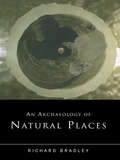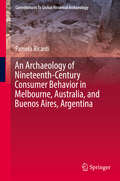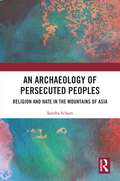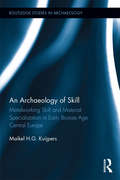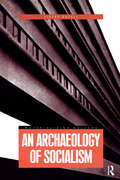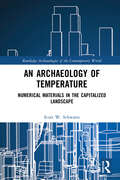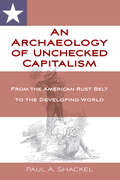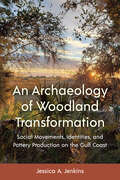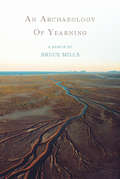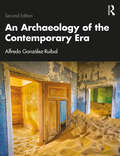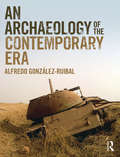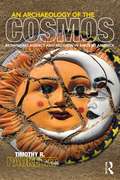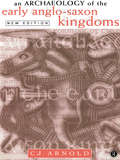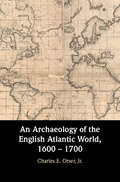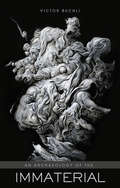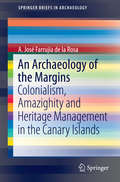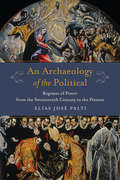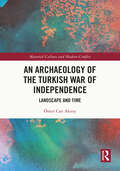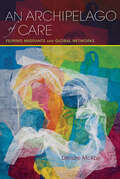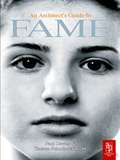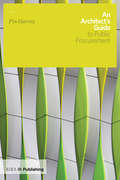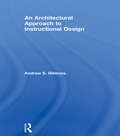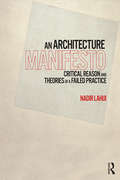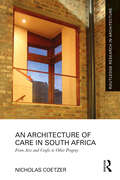- Table View
- List View
An Archaeology of Natural Places
by Richard BradleyThis volume explores why natural places such as caves, mountains, springs and rivers assumed a sacred character in European prehistory, and how the evidence for this can be analysed in the field. It shows how established research on votive deposits, rock art and production sites can contribute to a more imaginative approach to the prehistoric landscape, and can even shed light on the origins of monumental architecture. The discussion is illustrated through a wide range of European examples, and three extended case studies.An Archaeology of Natural Places extends the range of landscape studies and makes the results of modern research accessible to a wider audience, including students and academics, field archaeologists, and those working in heritage management.
An Archaeology of Nineteenth-Century Consumer Behavior in Melbourne, Australia, and Buenos Aires, Argentina (Contributions To Global Historical Archaeology)
by Pamela RicardiThis book compares consumer behavior in two nineteenth-century peripheral cities: Melbourne, Australia and Buenos Aires, Argentina. It provides an analysis of domestic archaeological assemblages from two inner-city working class neighborhood sites that were largely populated by recently arrived immigrants.The book also uses primary, historical documents to assess the place of these cities within global trade networks and explores the types of goods arriving into each city. By comparing the assemblages and archival data it is possible to explore the role of choice, ethnicity, and class on consumer behavior. This approach is significant as it provides an archaeological assessment of consumer behavior which crosses socio-political divides, comparing a site within a British colony to a site in a former Spanish colony in South America. As two geographically, politically and ethnically distinct cities it was expected that archaeological and archival data would reveal substantial variation. In reality, differences, although noted, were small. Broad similarities point to the far-reaching impact of colonialism and consumerism and widespread interconnectedness during the nineteenth century. This book demonstrates the wealth of information that can be gained from international comparisons that include sites outside the British Empire.
An Archaeology of Persecuted Peoples: Religion and Hate in the Mountains of Asia
by Sandra SchamThis book examines the pasts and presents of some of the world’s most persecuted peoples, in search of answers to the question of why minorities living in Asia’s Highlands, with ancient roots in their homelands, have been continually oppressed by both historical and modern governments. The role of religious beliefs and practices is crucial to their story of isolation, tenacity, and resistance in the mountains of Asia. The Rohingya, Uyghurs, Hazara, Yazidis, Armenians, and Samaritans were among the earliest adopters of monotheist religions in their respective regions. The chapters devoted to each of these ethno-religious minorities explore the archaeological evidence for their millennia-old presence in South, East, and West Asia, their historical trajectories, and the more recent events that have decimated their populations and destroyed their ways of living. Examining both the parochial and universalist roots of their beliefs and practices as they evolved from the Axial Age teachings of Zoroaster, the Israelite prophets, and Ancient Greek philosophers, this book explains how the people of the Arakan, Tienshan, Hazarajat, Sinjar, Tauru,s and Gerizim mountains came to be regarded as perennial enemies of empires and nations.
An Archaeology of Skill: Metalworking Skill and Material Specialization in Early Bronze Age Central Europe (Routledge Studies in Archaeology)
by Maikel H.G. KuijpersMaterial is the mother of innovation and it is through skill that innovations are brought about. This core thesis that is developed in this book identifies skill as the linchpin of – and missing link between – studies on craft, creativity, innovation, and material culture. Through a detailed study of early bronze age axes the question is tackled of what it involves to be skilled, providing an evidence based argument about levels of skill. The unique contribution of this work is that it lays out a theoretical framework and methodology through which an empirical analysis of skill is achievable. A specific chaîne opératoire for metal axes is used that compares not only what techniques were used, but also how they were applied. A large corpus of axes is compared in terms of what skills and attention were given at the different stages of their production. The ideas developed in this book are of interest to the emerging trend of ‘material thinking’ in the human and social sciences. At the same time, it looks towards and augments the development in craft-studies, recognising the many different aspects of craft in contemporary and past societies, and the particular relationship that craftspeople have with their material. Drawing together these two distinct fields of research will stimulate (re)thinking of how to integrate production with discussions of other aspects of object biographies, and how we link arguments about value to social models.
An Archaeology of Socialism (Materializing Culture)
by Victor BuchliThis highly original case study, which adopts a material culture perspective, is unprecedented in social and cultural histories of the Soviet period and provides a unique window on social relations. The author demonstrates how Moisei Ginzburg's Constructivist masterpiece, the Narkomfin Communal House, employed classic Marxist understandings of material culture in an effort to overturn capitalist and patriarchal social structures. Through the edifying effects of architectural forms, Ginzburg attempted to induce socialist and feminist-inspired social and gender relations. The author shows how, for the inhabitants, these principles manifested themselves, from taste to hygiene to gender roles, and how individuals variously appropriated architectural space and material culture to cope with the conditions of daily life, from the utopianism of the First Five Year Plan and Stalin's purges to the collapse of the Soviet Union. This book makes a major contribution to: the history of socialism in the Soviet Union and, more generally, Eastern Europe; material culture studies; architectural history; archaeology and social anthropology.
An Archaeology of Temperature: Numerical Materials in the Capitalized Landscape (Routledge Archaeologies of the Contemporary World)
by Scott W. SchwartzThis work investigates the material culture of public temperatures in New York City. Numbers like temperature, while ubiquitous and indispensable to capitalized social relations, are often hidden away within urban infrastructures evading attention. This Archaeology of Temperature brings such numbers to light, interrogating how we construct them and how they construct us. Building on discussions in contemporary archaeology this book challenges the border between material and discursive culture, advocating for a novel conception of capitalism’s artifacts. The artifacts examined within (temperatures) are instantaneous electric pulses, algorithmic outputs, and momentary fluctuations in mercury. The artifacts of the capitalized never sit still, operating at subatomic and solar scales. Temperatures, as numerical materials precariously straddling the colonially constructed nature-culture divide, exemplify the abstraction necessary to pursue the perpetually accelerating asymmetrical growth of wealth—a pursuit that engenders multiple environmental and economic calamities. An Archaeology of Temperature innovatively reimagines theory and method within contemporary archaeology. Equally, in plummeting the depths of temperature, this book offers indispensable contributions to science studies, urban geography, semiotics, the philosophy of materiality, the history of thermodynamics, heterodox economics, performative scholarship, and queer ecocriticism.
An Archaeology of Unchecked Capitalism: From the American Rust Belt to the Developing World
by Paul ShackelThe racialization of immigrant labor and the labor strife in the coal and textile communities in northeastern Pennsylvania appears to be an isolated incident in history. Rather this history can serve as a touchstone, connecting the history of the exploited laborers to today’s labor in the global economy. By drawing parallels between the past and present – for example, the coal mines of the nineteenth-century northeastern Pennsylvania and the sweatshops of the twenty-first century in Bangladesh – we can have difficult conversations about the past and advance our commitment to address social justice issues.
An Archaeology of Woodland Transformation: Social Movements, Identities, and Pottery Production on the Gulf Coast (Florida Museum of Natural History: Ripley P. Bullen Series)
by Jessica A. JenkinsExploring a period of transformative change for the Woodland-era societies of Florida’s Lower Suwannee region In this book, Jessica Jenkins provides a detailed look at the transition from the Middle to Late Woodland periods in the Lower Suwannee region of Florida’s Gulf Coast. Drawing on ceramic analysis techniques, Jenkins argues that this time of transformative change, often interpreted as a societal collapse, instead should be seen as a purposeful shift brought about by emerging social movements. Beginning around 650 CE, the region’s Indigenous inhabitants dispersed from civic-ceremonial centers, moved away from places associated with the dead, changed their burial practices, and adopted new pottery surface treatments and designs. Examining ceramic vessels from 12 sites located on islands near the present-day town of Cedar Key, Jenkins catalogs these shifts. Jenkins explores how people shared social identities that connected them through relational networks and laid the foundation for these changes. An Archaeology of Woodland Transformation is the first book to synthesize information on the villages, networks, and identities of this time and place. Offering rich datasets and new perspectives on sociocultural transformation in and around the lower Suwannee River Estuary, this book represents a breakthrough in current understandings of the Woodland period. A volume in the Florida Museum of Natural History: Ripley P. Bullen Series
An Archaeology of Yearning
by Bruce MillsDigging into vivid moments within the metaphor of archaeology, Bruce Mill's remarkable memoir maps the artifacts of life as a father of a boy with autism, and as a boy himself growing up in rural Iowa. An Archaeology of Yearning is not ultimately about autism; instead it reaches into the world of human connection and illuminates how storytelling and an understanding of language keep that connection alive.On some nights, I awake as if in a cave and think of the future. Mary and I will exist as memories: a quick glimpse of arms reaching toward another's shoulders or face, an image of a hand upon a book, the scent of our bodies after the sweat of sleep, the tone of our young and old voices calling our daughter or son from distant rooms or down a stair.Eventually I arrive on the image of my son, in some new home. No matter how much I have written or catalogued or kept in images, I know that the site of his life and mine will inevitably remain fragments and that only a visitor can bring us to life.Bruce Mills has published scholarly books and articles on nineteenth-century American writings and co-edited a collection of essays by siblings of those on the autism spectrum. His creative nonfiction has appeared in The Georgia Review and New England Review. He teaches in the English Department at Kalamazoo College.
An Archaeology of the Contemporary Era
by Alfredo Gonzalez-RuibalThe second edition of An Archaeology of the Contemporary Era explores the period between the late nineteenth and twenty-first centuries and reflects on the archaeological theory and practice of the recent past.This book argues that the materiality of our times, and particularly its ruins and rubbish, reveals something profound and disturbing about modern societies. It examines the political, ethical, aesthetic, and epistemological foundations of contemporary archaeology and characterizes the excess of the contemporary period through its material traces. This book remains the first attempt at describing the contemporary era from an archaeological point of view. Global in scope, the book brings together case studies from every continent and considers sources from peripheral and rarely considered traditions, meanwhile engaging in interdisciplinary dialogue with philosophy, anthropology, history, and geography. This new edition includes the latest developments in the field, both methodological and theoretical, and adds new and exciting case studies to engage students. It also covers some of the most pressing issues of the present, as they are being addressed by archaeologists, such as pandemics, the antiracist movement, the global rise of reactionary populism, the ecological crisis, and climate change. An Archaeology of the Contemporary Era is essential reading for students and practitioners of the contemporary past, historical archaeology, and archaeological theory. It will also be of interest to anybody concerned with globalization, modernity, and the Anthropocene.
An Archaeology of the Contemporary Era: The Age of Destruction
by Alfredo Gonzalez-RuibalAn Archaeology of the Contemporary Era approaches the contemporary age, between the late nineteenth and twenty-first centuries, as an archaeological period defined by specific material processes. It reflects on the theory and practice of the archaeology of the contemporary past from epistemological, political, ethical and aesthetic viewpoints, and characterises the present based on archaeological traces from the spatial, temporal and material excesses that define it. The materiality of our era, the book argues, and particularly its ruins and rubbish, reveals something profound, original and disturbing about humanity. This is the first attempt at describing the contemporary era from an archaeological point of view. Global in scope, the book brings together case studies from every continent and considers sources from peripheral and rarely considered traditions, meanwhile engaging in an interdisciplinary dialogue with philosophy, anthropology, history and geography. An Archaeology of the Contemporary Era will be essential reading for students and practitioners of the archaeology of the contemporary past, historical archaeology and archaeological theory. It will also be of interest to anybody concerned with globalisation, modernity and the Anthropocene.
An Archaeology of the Cosmos: Rethinking Agency and Religion in Ancient America
by Timothy R. PauketatAn Archaeology of the Cosmos seeks answers to two fundamental questions of humanity and human history. The first question concerns that which some use as a defining element of humanity: religious beliefs. Why do so many people believe in supreme beings and holy spirits? The second question concerns changes in those beliefs. What causes beliefs to change? Using archaeological evidence gathered from ancient America, especially case material from the Great Plains and the pre-Columbian American Indian city of Cahokia, Timothy Pauketat explores the logical consequences of these two fundamental questions. Religious beliefs are not more resilient than other aspects of culture and society, and people are not the only causes of historical change. An Archaeology of the Cosmos examines the intimate association of agency and religion by studying how relationships between people, places, and things were bundled together and positioned in ways that constituted the fields of human experience. This rethinking theories of agency and religion provides readers with challenging and thought provoking conclusions that will lead them to reassess the way they approach the past.
An Archaeology of the Early Anglo-Saxon Kingdoms
by C. J. ArnoldAn Archaeology of the Early Anglo-Saxon Kingdoms is a volume which offers an unparalleled view of the archaeological remains of the period. Using the development of the kingdoms as a framework, this study closely examines the wealth of material evidence and analyzes its significance to our understanding of the society that created it. From our understanding of the migrations of the Germanic peoples into the British Isles, the subsequent patterns of settlement, land-use, trade, through to social hierarchy and cultural identity within the kingdoms, this fully revised edition illuminates one of the most obscure and misunderstood periods in European history.
An Archaeology of the English Atlantic World, 1600 – 1700
by Charles E. Orser Jr.An Archaeology of the British Atlantic World is the first book to apply the methods of modern-world archaeology to the study of the seventeenth-century English colonial world. Charles E. Orser, Jr explores a range of material evidence of daily life collected from archaeological excavations throughout the Atlantic region, including England, Ireland, western Africa, Native North America, and the eastern United States. He considers the archaeological record together with primary texts by contemporary writers. Giving particular attention to housing, fortifications, delftware, and stoneware, Orser offers new interpretations for each type of artefact. His study demonstrates how the archaeological record expands our understanding of the Atlantic world at a critical moment of its expansion, as well as to the development of the modern, Western world.
An Archaeology of the Immaterial
by Victor BuchliAn Archaeology of the Immaterial examines a highly significant but poorly understood aspect of material culture studies: the active rejection of the material world. Buchli argues that this is evident in a number of cultural projects, including anti-consumerism and asceticism, as well as other attempts to transcend material circumstances. Exploring the cultural work which can be achieved when the material is rejected, and the social effects of these ‘dematerialisations’, this book situates the way some people disengage from the world as a specific kind of physical engagement which has profound implications for our understanding of personhood and materiality. Using case studies which range widely in time over Western societies and the technologies of materialising the immaterial, from icons to the scanning tunnelling microscope and 3-D printing, Buchli addresses the significance of immateriality for our own economics, cultural perceptions, and emerging forms of social inclusion and exclusion. An Archaeology of the Immaterial is thus an important and innovative contribution to material cultural studies which demonstrates that the making of the immaterial is, like the making of the material, a profoundly powerful operation which works to exert social control and delineate the borders of the imaginable and the enfranchised.
An Archaeology of the Margins: Colonialism, Amazighity and Heritage Management in the Canary Islands (SpringerBriefs in Archaeology)
by A. José Farrujia de la RosaThis book analyses the problematics of archaeological heritage management in the Canary Islands, which are echoed in other parts of the world where the indigenous heritage is under-represented. The present-day management of Canarian archaeological heritage has a very specific and unusual context given that the archipelago is located on the fringes of Europe, belonging to Spain and therefore to the European Unión, but geographically and in terms of early history being part of Africa. From a theoretical perspective, then, the proposed book analyzes issues such as the effects of colonialism and eurocentrism on the management of the archaeological heritage. It also examines the evolutionist and historico-cultural models used to analyze past societies and, ultimately, used to create identities that influence archaeological heritage management itself. From a practical point of view, the book presents a proposal for enhancing the archaeological heritage of the Canary Islands through the creation of archaeological parks (providing some concrete examples in the case of the city of La Laguna) and the active involvement of the local community. Parallel to this, the book considers the Canarian Archipelago as part of a problematic that is not unique to this area but is an example of poor indigenous heritage management overall. It demonstrates how the course of history and the politics of the past still have an excessive influence on the way in which the present-day archaeological heritage is interpreted and managed. Therefore, this book provides an almost unique opportunity for uncovering the history of archaeology within the margins of Europe (in fact, in an African region) and exploring colonial and foreign influences. In many ways it is a mirror of archaeological mainstreams and an exercise in (re)thinking the aim and status of present-day archaeology.
An Archaeology of the Political: Regimes of Power from the Seventeenth Century to the Present (Columbia Studies in Political Thought / Political History)
by Elías PaltiIn the past few decades, much political-philosophical reflection has been dedicated to the realm of "the political." Many of the key figures in contemporary political theory—Jacques Rancière, Alain Badiou, Reinhart Koselleck, Giorgio Agamben, Ernesto Laclau, and Slavoj i ek, among others—have dedicated themselves to explaining power relations, but in many cases they take the concept of the political for granted, as if it were a given, an eternal essence.In An Archaeology of the Political, Elías José Palti argues that the dimension of reality known as the political is not a natural, transhistorical entity. Instead, he claims that the horizon of the political arose in the context of a series of changes that affirmed the power of absolute monarchies in seventeenth-century Europe and was successively reconfigured from this period up to the present. Palti traces this series of redefinitions accompanying alterations in regimes of power, thus describing a genealogy of the concept of the political. Perhaps most important, An Archaeology of the Political brings to theoretical discussions a sound historical perspective, illuminating the complex influences of both theology and secularization on our understanding of the political in the contemporary world.
An Archaeology of the Soul: North American Indian Belief and Ritual
by Robert L. HallThis book describes North American Indian beliefs and rituals. It also includes bibliographical references and an index.
An Archaeology of the Turkish War of Independence: Landscape and Time (Material Culture and Modern Conflict)
by Ömer Can AksoyThis book is about the conflict which resolved the Greek–Turkish War of 1919–1922: the Great Offensive. On 26 August 1922, the army of the GNA executed the Great Offensive against the Greek defence line extending from the Bay of Gemlik to the Meander River. The Turkish Forces split the Greek Army into two large groups, annihilated one of the groups in the field at the Battle of Dumlupınar on 30 August and pursued the remaining forces of the Greek Army towards the Aegean and Marmara coasts until 18 September. Within these 24 days, the face of Western Anatolia changed unalterably: numerous towns, villages and cities of Western Anatolia were reduced to ashes. This conflict was a turning point in the histories of Turkey and Greece, as it played a significant role in shaping the present-day demographic and geopolitical landscapes of both nations. It resulted in a population exchange in 1923 that dramatically altered the lives of Muslims in Greece and Greek Orthodox people in Turkey and paved the way to the foundation of the Republic of Turkey. Despite the outcome of this war and the existence of a rich literature on its military and political history, the landscapes, memoryscapes and material culture have not been systematically investigated. This book bridges that gap via an archaeological, historical and oral-historical study of the Great Offensive and its aftermath. With its wide chronological perspective, this book is not a pure analysis of a historical war, it is instead a journey into the foundation myth of the Turkish Republic and the ideological foundations of the Turkish state.
An Archipelago of Care: Filipino Migrants and Global Networks (Framing the Global)
by Deirdre McKayA study of Filipino caregivers in London and what it says for migrant workers and the networks they build in the global marketplace.Focusing on the experience of Filipino caregivers in London, some of whom are living and working illegally in their host country, Deirdre McKay considers what migrant workers must do to navigate their way in a global marketplace. She draws on interviews and participant observations, her own long-term fieldwork in communities in the Philippines, and digital ethnography to present an intricate consideration of how these caregivers create stability in potentially precarious living situations. McKay argues that these workers gain resilience from the bonding networks they construct for themselves through social media, faith groups, and community centers. These networks generate an elaborate “archipelago of care” through which migrants create their sense of self.“A beautifully written ethnography of Filipino migrants in the UK and their experience of living their lives within and across the UK and the Philippines, mediated by physical space, institutions and a series of digital media.” —Heather Horst, coauthor of Digital Ethnography: Principles and Practices“Deirdre McKay takes a novel approach to key concepts undergirding globalization and transnationalism today—citizenship, surveillance, and security. She makes us think differently about the negotiation of belonging in a digital and hyper-securitized age.” —Jennifer Burrell, author of Maya After War: Conflict, Power, and Politics in Guatemala
An Architect's Guide to Fame
by Paul Davies Torsten SchmiedeknechtThis lively text provides a candid inquiry into the contemporary means by which architects get work and (for better or worse) become famous. In response to the reciprocal relationship between publicity and everyday architectural practice, this book examines the mechanisms by which architects seek publicity and manage to establish themselves and their work ahead of their colleagues. Through the essays of specialist contributors, this book enables the reader to understand the complex relationship between what they see as the built environment and the unwritten stories behind how it came about.
An Architect's Guide to Public Procurement
by Fin GarveyThere is suspicion in the UK and across Europe that the upcoming introduction of new European Directives will encourage a regime of conservatism and legal risk aversion, fostering the delivery of mediocre and banal building design. This book dispels these myths and instead looks at the genuine impact of EU law on architectural practice.Engaging in public sector work requires a broad understanding of this seemingly complex and constantly evolving subject, and unlike other texts, the book is designed to explore public procurement from the perspective of the architect. An easy to follow guide through the complex legal and technical jargon involved in the procurement process, the book provides practical tools which will assist architects in developing their own, clear procurement strategy.Although written with a UK audience in mind, the advice will also be applicable to other European jurisdictions. It is invaluable reading for existing practitioners wishing to expand their current involvement in the public procurement process, as well as those encountering it for the first time.
An Architectural Approach to Instructional Design
by Andrew S. GibbonsWinner of the 2014 AECT Design & Development Outstanding Book Award An Architectural Approach to Instructional Design is organized around a groundbreaking new way of conceptualizing instructional design practice. Both practical and theoretically sound, this approach is drawn from current international trends in architectural, digital, and industrial design, and focuses on the structural and functional properties of the artifact being designed rather than the processes used to design it. Harmonious with existing systematic design models, the architectural approach expands the scope of design discourse by introducing new depth into the conversation and merging current knowledge with proven systematic techniques. An architectural approach is the natural result of increasing technological complexity and escalating user expectations. As the complexity of design problems increases, specialties evolve their own design languages, theories, processes, tools, literature, organizations, and standards. An Architectural Approach to Instructional Design describes the implications for theory and practice, providing a powerful and commercially relevant introduction for all students of instructional design.
An Architecture Manifesto: Critical Reason and Theories of a Failed Practice
by Nadir LahijiWhat is a manifesto? In basic terms, a manifesto is ‘the invention of future for the present’. We have been oblivious to the fact that the twentieth century was the century of manifestos. It was the century of programmatic declarations, radical and avant-garde political, artistic and architectural proclamations. Manifestos came to be a genre of concise and radical-critical writings exposing the repressed contradictions in a dominant doctrine. They opened up the present to the future by denouncing the forces of the status quo and offering alternative programs. Today, this genre is a more valid, even urgent, form of writing for our time, in order to expose the dominant doctrine that has closed the future in subscribing to the ideology of the ‘end of history’. In this manifesto, Nadir Lahiji takes a leap of faith. It is a faith in Lost Causes. He asserts that today, architectonic reason has fallen into ruins. As soon as architecture leaves the limits set to it by architectonic reason, no other path is open to it but the path to aestheticism. This is the wrong path contemporary architecture has taken. In its reduction to a pure aesthetic object, architecture negatively affects the human sensorium. Capitalist consumer society creates desires by generating ‘surplus-enjoyment’ for capitalist profit and contemporary architecture has become an instrument in generating this ‘surplus-enjoyment’, with fatal consequences. This manifesto is thus both a critique and a work of theory. It is a siren, alarm, klaxon to the current status quo within architectural discourse and a timely response to the conditions of architecture today.
An Architecture of Care in South Africa: From Arts and Crafts to Other Progeny (Routledge Research in Architecture)
by Nicholas CoetzerArchitects care. It is foundational and germane to the discipline and practice of architecture. This book charts the way the Arts and Crafts Movement established the moral ethos of ‘an architecture of care’ that not only remains embedded in current discourse and practice but also that is being given a more vocal presence in our climate-crisis and social justice world. By way of ‘genealogical strands’ the book charts the origin of ‘architecture of care’ ideas in the Arts and Crafts Movement and their impact on the ‘other progeny’ architectural projects in South Africa over the past hundred years. These range from the translation of inglenooks into an armature architecture of ‘Dignified Places’ in Cape Town’s townships to the ethos of ‘upliftment’ and care that translates from Octavia Hill through to ‘correcting’ building regulations and eventually finding a less moralising and more transformative impact in the ‘Hostels to Homes’ project. The birth of design through context and climate in the Arts and Crafts Movement is demonstrated by the shift in South African houses from boxy cottages to solar- and nature-oriented ribbon plans as demonstrated through the work of Helmut Stauch and Norman Eaton. The dislocation of Arts and Crafts ideas to the Cape also demonstrated a limit to the valorising of vernacular architecture and its ‘against-globalization’ building materials whereby English architects promoted Cape Dutch settler architecture and denigrated African vernacular architecture. As a final ‘genealogical strand,’ the book demonstrates the coherence of moral instrumentality with the animism and affects potential of handmade buildings. Written for academics, students and researchers interested in architectural history, it is an eye-opening investigation into the role of architecture in society.
